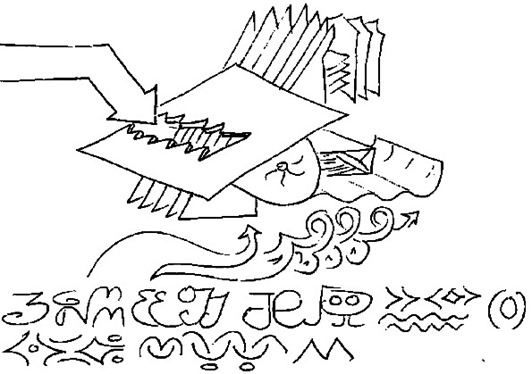Adam Blatner
Words and Images from the Mind of Adam Blatner
A Component “Next Step”
Originally posted on December 21, 2013
What is illustrated below is Task 4b: This shows how multi-contextual paradigms are affected by shifting aesthetic criteria.
It was not really possible to reveal this task to any member of humanity until now, as the species as a whole was rather immature, and many of the concepts thus named in this task were really quite incomprehensible. They are so even today for most mortals. We had to evolve a hybrid being, the translator, Adam, who is 1/3 elf, or trans-dimensionally-minded, who can interpret this task to humans. This couldn’t happen until it is happening. You can’t hurry evolution.
The task is one of many—“4-B” as we call it: What is shown is a rough illustration of the way our multi-contextual paradigm(s) are characterized by shifting aesthetic criteria. We begin by noting a flat plane with a sort of “rip” in it, revealing perpendicular sub-realms beneath it. That, with Adam’s help as translator, diagrams the way ordinary waking “reality” as imagined as the same for all, a consensus reality, underneath, is fed into by a multiplicity of more individuated subconscious frames—each of which has it’s own criteria for value—criteria that are more aesthetic than rational. There are other “objects” shown, each one symbolizing a different subconscious reality element—and these must be symbols because what they symbolize cannot be represented in three dimensional—much less two-dimensional—space. Each is not only multi-dimensional, but also trans-dimensional, being affected by and in turn affecting the currents that lie “beneath” them and move out as waves “from” them.
These are what we mean by multi-contextual paradigms, which is one way to express the “anatomy” or underlying structure of your cosmos. The problem (for you) is that the aesthetic criteria shift. For example, sometimes you lose interest, or can’t sustain your focus; sometimes they are frightening or attractive, even with sexual resonances; sometimes you just feel sleepy, at other times, more vibrantly awake, and you don’t even know why. These states of mind all result from the shift in aesthetic criteria, a process that is as yet both extremely intimate, felt, familiar, and yet foreign in the sense that no present cultural realities acknowledge that this dimension of mind-change occurs.
This is because your species for the most part still believes that “there” is a reality, an “out-there,” one that is not constantly co-created by your minds, individual a collective. That is to say, if you can handle it, and we’ve been told that now is the time to try to communicate this: There is no “there,” no outward firm reality that operates apart from your consensus; nor yet is it so that it’s “all” in your heads, because there are innumerable other co-creative forces operating. There’s no matter quite independent of mind—that’s the point—and mind is influenced according to the paradigms or worldviews of that mind’s environment as well as the vagaries of the mind’s moods, expressed in shifting aesthetic criteria.
Well, I’ve tried to make it as clear as I can. Those with ears to hear, let them hear.

Leave a Reply